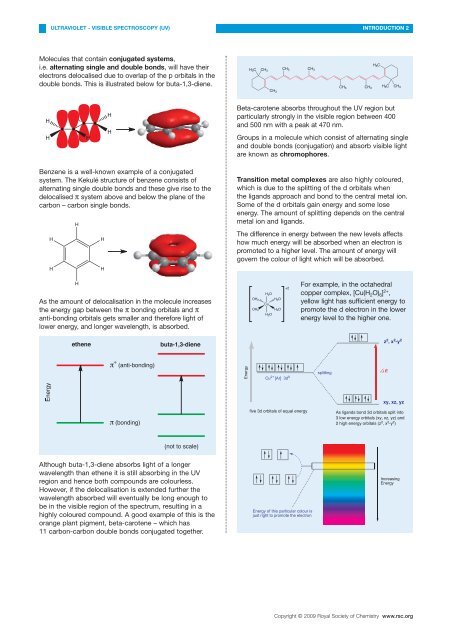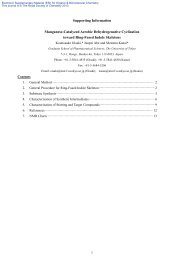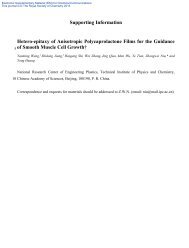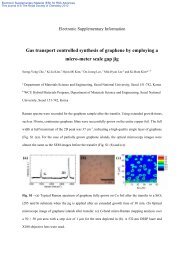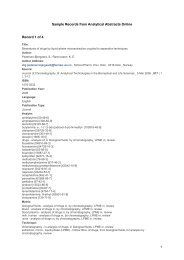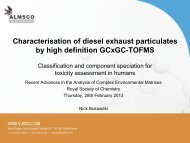Spectroscopy in a Suitcase - Royal Society of Chemistry
Spectroscopy in a Suitcase - Royal Society of Chemistry
Spectroscopy in a Suitcase - Royal Society of Chemistry
Create successful ePaper yourself
Turn your PDF publications into a flip-book with our unique Google optimized e-Paper software.
ULTRAVIOLET - VISIBLE SPECTROSCOPY (UV)<br />
INTRODUCTION 2<br />
Molecules that conta<strong>in</strong> conjugated systems,<br />
i.e. alternat<strong>in</strong>g s<strong>in</strong>gle and double bonds, will have their<br />
electrons delocalised due to overlap <strong>of</strong> the p orbitals <strong>in</strong> the<br />
double bonds. This is illustrated below for buta-1,3-diene.<br />
Beta-carotene absorbs throughout the UV region but<br />
particularly strongly <strong>in</strong> the visible region between 400<br />
and 500 nm with a peak at 470 nm.<br />
Groups <strong>in</strong> a molecule which consist <strong>of</strong> alternat<strong>in</strong>g s<strong>in</strong>gle<br />
and double bonds (conjugation) and absorb visible light<br />
are known as chromophores.<br />
Benzene is a well-known example <strong>of</strong> a conjugated<br />
system. The Kekulé structure <strong>of</strong> benzene consists <strong>of</strong><br />
alternat<strong>in</strong>g s<strong>in</strong>gle double bonds and these give rise to the<br />
delocalised V system above and below the plane <strong>of</strong> the<br />
carbon – carbon s<strong>in</strong>gle bonds.<br />
Transition metal complexes are also highly coloured,<br />
which is due to the splitt<strong>in</strong>g <strong>of</strong> the d orbitals when<br />
the ligands approach and bond to the central metal ion.<br />
Some <strong>of</strong> the d orbitals ga<strong>in</strong> energy and some lose<br />
energy. The amount <strong>of</strong> splitt<strong>in</strong>g depends on the central<br />
metal ion and ligands.<br />
The difference <strong>in</strong> energy between the new levels affects<br />
how much energy will be absorbed when an electron is<br />
promoted to a higher level. The amount <strong>of</strong> energy will<br />
govern the colour <strong>of</strong> light which will be absorbed.<br />
As the amount <strong>of</strong> delocalisation <strong>in</strong> the molecule <strong>in</strong>creases<br />
the energy gap between the V bond<strong>in</strong>g orbitals and V<br />
anti-bond<strong>in</strong>g orbitals gets smaller and therefore light <strong>of</strong><br />
lower energy, and longer wavelength, is absorbed.<br />
For example, <strong>in</strong> the octahedral<br />
copper complex, [Cu(H 2 O) 6 ] 2+ ,<br />
yellow light has sufficient energy to<br />
promote the d electron <strong>in</strong> the lower<br />
energy level to the higher one.<br />
Although buta-1,3-diene absorbs light <strong>of</strong> a longer<br />
wavelength than ethene it is still absorb<strong>in</strong>g <strong>in</strong> the UV<br />
region and hence both compounds are colourless.<br />
However, if the delocalisation is extended further the<br />
wavelength absorbed will eventually be long enough to<br />
be <strong>in</strong> the visible region <strong>of</strong> the spectrum, result<strong>in</strong>g <strong>in</strong> a<br />
highly coloured compound. A good example <strong>of</strong> this is the<br />
orange plant pigment, beta-carotene – which has<br />
11 carbon-carbon double bonds conjugated together.<br />
Copyright © 2009 <strong>Royal</strong> <strong>Society</strong> <strong>of</strong> <strong>Chemistry</strong> www.rsc.org


